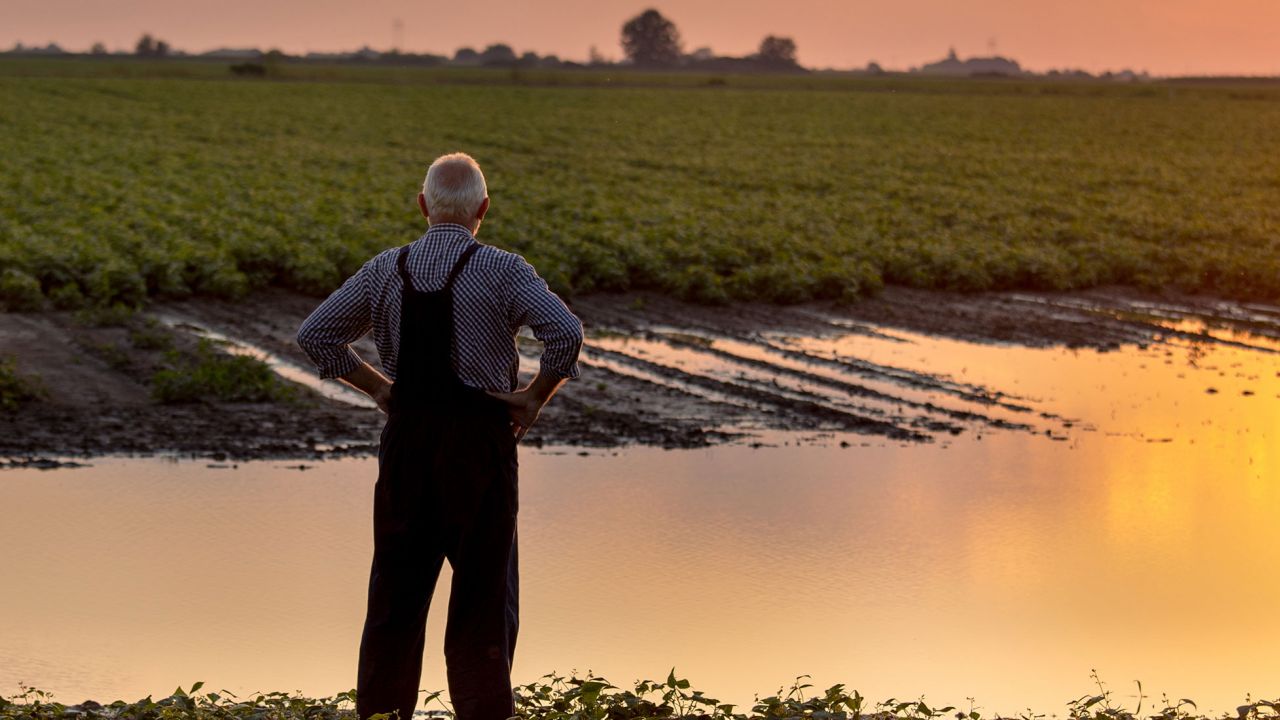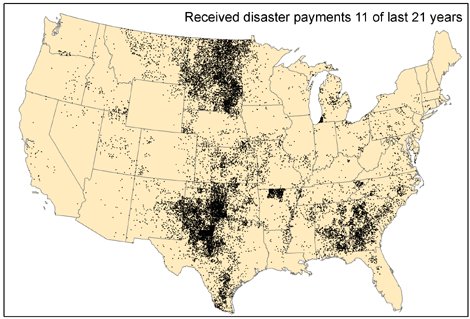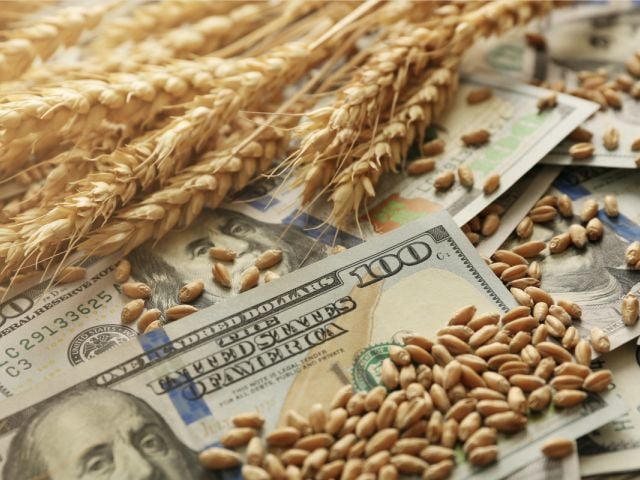
Overview
- Overview bullet 1
- Overview bullet 2
- Overview bullet 3
Plans for a permanent trust fund to compensate farmers and ranchers for weather-related losses will send even more agricultural subsidies to the very regions that already receive the lion’s share. Based on their historical share of ad hoc disaster spending, of the twenty states represented on the Senate Finance Committee, just four stand to gain over half (55 percent) of the committee’s allocation of disaster aid expenditures under a permanent fund: North Dakota, Kansas, Iowa and Montana.
Every year, Congress is pressed to provide emergency ad hoc disaster aid to farmers and ranchers who have suffered weather damage to crops and livestock. Over the past 21 years (1985-2005), taxpayers have provided $26 billion in emergency agricultural disaster aid to more than two million farm and ranch operations. USDA sent out disaster aid checks every year for the past two decades, with payouts exceeding one billion dollars in 11 of the 21 years. (The $26 billion total does not include billions more paid through the heavily subsidized federal crop insurance program or the "emergency economic assistance" that roughly doubled subsidies for commodity crop farmers between 1998 and 2002.)
Now the Senate Finance Committee reportedly is considering a permanent trust fund that would set aside $5 billion that could be paid in disaster aid to farmers and ranchers without resort to ad hoc legislation.
Our review shows that most of this $5 billion would go to just a few states where agricultural disaster “emergencies” are in fact routine, virtually annual occurrences, primarily because of low rainfall. These same states are among the biggest recipients of crop subsidies, conservation aid, and federally subsidized crop insurance claims.
EWG examined the history of disaster aid payments to the 20 states currently represented on the Senate Finance Committee and found that over the past 21 years, those states have collected some $9 billion in ad hoc disaster payments, roughly one-third of the $26 billion total paid nationwide. However, just four states on the committee collected 55 percent of that $9 billion (North Dakota, Kansas, Iowa and Montana). Future disaster aid is expected to follow the same pattern.
EWG’s analysis raises the question of whether it is fair to designate such a large portion of revenues to a single purpose that mostly benefits just a few states on the committee. Other states represented on Senate Finance have higher priority agriculture-related needs for such funds, including conservation, rural development, or specialty crop agriculture. These priorities have never been funded through ad hoc assistance and are, in fact, perennially short-changed by federal farm and appropriations policy decisions. Indeed, in recent years, conservation and other programs have had their funds cut in order to pay for disaster aid.
The concentrated, predictable, repetitive nature of agricultural disaster aid among a few states with perennially poor growing conditions also raises the question of whether the time has come for states to assume a primary role in providing agricultural disaster assistance within their borders.
Patterns of disaster aid dependency
Within the states where farm disaster payments are routine are tens of thousands of farmers who have collected them every other year, or more frequently, over two decades.
Recipients of disaster payments in 11 or more years out of the last 21 years

1 dot = 1 recipient
Source: Environmental Working Group. Compiled from USDA data.
Indeed, agricultural disaster aid should be thought of as serving two distinct groups of farmers and ranchers. The overwhelming majority rarely receives disaster checks from taxpayers, and the amount of assistance is modest. The second group, the primary source of the political pressure for disaster aid every year, is a small minority of the recipients who are chronically dependent on disaster aid. Over two decades this group has collected ad hoc disaster checks every other year, if not more frequently.
A review of millions of disaster aid payments since 1985 shows that the vast majority of the 2 million farmers and ranchers who have received disaster aid over the past 21 years have received it infrequently, with 75 percent collecting payments three years or less out of 21 (Table 1).
Table 1. Disaster aid dependency
| Number of years receiving disaster payments |
Number recipients receiving disaster payments |
Average disaster payment, 1985-2005 |
Total disaster payments, 1985-2005 |
Percent of recipients |
|---|---|---|---|---|
| 1 | 848,431 | $3,000 | $2,545,293,000 | 41.7% |
| 2 | 431,431 | $6,605 | $2,849,688,041 | 21.2% |
| 3 | 260,066 | $11,493 | $2,989,024,360 | 12.8% |
| 4 | 171,641 | $17,253 | $2,961,320,457 | 8.4% |
| 5 | 109,098 | $25,445 | $2,776,025,885 | 5.4% |
| 6 | 72,821 | $33,190 | $2,416,928,990 | 3.6% |
| 7 | 48,784 | $43,286 | $2,111,661,785 | 2.4% |
| 8 | 33,990 | $54,326 | $1,846,524,425 | 1.7% |
| 9 | 23,200 | $68,560 | $1,590,583,184 | 1.1% |
| 10 | 15,227 | $84,786 | $1,291,035,813 | 0.75% |
| 11 | 9,752 | $99,900 | $974,220,607 | 0.48% |
| 12 | 5,791 | $115,827 | $670,755,547 | 0.28% |
| 13 | 3,083 | $136,120 | $419,657,559 | 0.15% |
| 14 | 1,509 | $155,086 | $234,024,216 | 0.07% |
| 15 | 680 | $178,627 | $121,466,258 | 0.03% |
| 16 | 218 | $224,169 | $48,868,809 | 0.01% |
| 17 | 45 | $271,196 | $12,203,831 | < 0.01% |
| 18 | 6 | $516,342 | $3,098,051 | < 0.01% |
| 19 | 1 | $229,547 | $229,547 | < 0.01% |
| 11 or more | 21,081 | $117,834 | $2,484,524,425 | 1.0% |
| 14 or more | 2,459 | $170,757 | $419,890,712 | 0.12% |
Source: Environmental Working Group. Compiled from USDA data.
But a minority of the recipients are chronic beneficiaries of disaster funds, with some 21,000 of them (about 1 percent of recipients) collecting disaster aid more than 11 years out of 21, amounting to $2.5 billion, or almost 10 percent of the total payments (Table 1). These chronic beneficiaries, on average, collected payments for 12 of 21 years and received an average of $118,000 a piece in aid.
This small minority of farmers, located in a handful of states, would be the chief beneficiaries of a permanent trust fund for disaster aid because they would be applying for it almost every year.
We found 2,459 recipients, (0.12 percent of recipients) who collected $420 million, or 1.6 percent of the so-called "emergency" disaster payments 14 years or more out the past 21 years, or two thirds of the time.
While every state received at least some disaster payments over the period, five states--Texas, South Dakota, North Dakota, Oklahoma and Georgia--account for 67 percent of the chronic beneficiaries who collected disaster funds every other year, or more often, for two decades (Table 2). The heavy concentration of chronic recipients in Texas, South Dakota, North Dakota and Oklahoma simply reflects the difficulty of raising crops and to a lesser degree livestock in a region of perennially low rainfall. It also raises the question of whether taxpayers ought to be obligated to provide a continuous stream of aid when "disaster emergency" is the rule and not the exception.
Table 2. Top States for chronic disaster aid recipients
| Rank | State | Number of recipients receiving disaster payments in 11 or more years |
Total Disaster Payments to Chronic Recipients 1985-2005 |
Percent of Chronic Recipients |
|---|---|---|---|---|
| 1 | Texas | 5,419 | $669,337,350 | 26% |
| 2 | South Dakota | 2,550 | $266,038,999 | 12% |
| 3 | North Dakota | 2,260 | $270,888,734 | 11% |
| 4 | Oklahoma | 2,084 | $180,322,336 | 10% |
| 5 | Georgia | 1,553 | $209,700,052 | 7% |
| 6 | Alabama | 766 | $89,252,141 | 4% |
| 7 | Kansas | 715 | $50,223,782 | 3% |
| 8 | Arkansas | 662 | $38,023,336 | 3% |
| 9 | Montana | 626 | $88,484,307 | 3% |
| 10 | New Mexico | 575 | $64,261,538 | 3% |
| 11 | Minnesota | 362 | $45,392,250 | 1.7% |
| 12 | Nebraska | 354 | $28,117,230 | 1.7% |
| 13 | Missouri | 313 | $24,392,345 | 1.5% |
| 14 | South Carolina | 302 | $42,481,335 | 1.5% |
| 15 | Michigan | 288 | $54,554,669 | 1.4% |
| 16 | North Carolina | 274 | $53,236,633 | 1.3% |
| 17 | Tennessee | 182 | $17,227,175 | 0.9% |
| 18 | Mississippi | 153 | $20,428,570 | 0.7% |
| 19 | Utah | 129 | $19,826,226 | 0.6% |
| 20 | Florida | 123 | $34,676,786 | 0.6% |
| 21 | Pennsylvania | 109 | $9,143,426 | 0.5% |
| 22 | Idaho | 108 | $21,133,248 | 0.5% |
| 23 | Ohio | 105 | $15,893,956 | 0.5% |
| 24 | Colorado | 96 | $15,787,063 | 0.5% |
| 25 | Virginia | 81 | $13,897,191 | 0.4% |
| 26 | Louisiana | 79 | $11,788,768 | 0.4% |
| 27 | Illinois | 75 | $6,724,459 | 0.4% |
| 28 | Iowa | 69 | $5,507,568 | 0.3% |
| 29 | Washington | 42 | $4,978,473 | 0.20% |
| 30 | Wyoming | 39 | $5,542,946 | 0.19% |
| 31 | California | 34 | $7,549,930 | 0.16% |
| 32 | New York | 32 | $4,667,972 | 0.15% |
| 33 | Oregon | 31 | $5,981,205 | 0.15% |
| 34 | Kentucky | 29 | $1,928,564 | 0.14% |
| 35 | Wisconsin | 28 | $3,850,056 | 0.13% |
| 36 | Indiana | 28 | $5,680,017 | 0.13% |
| 37 | >Maryland | 26 | $3,600,723 | 0.13% |
| 38 | Nevada | 21 | $6,909,469 | 0.10% |
| 39 | Arizona | 17 | $2,263,696 | 0.08% |
| 40 | Massachusetts | 12 | $2,695,900 | 0.06% |
| 41 | West Virginia | 11 | $1,889,213 | 0.05% |
| 42 | New Jersey | 11 | $2,973,001 | 0.05% |
| 43 | Connecticut | 10 | $4,315,260 | 0.05% |
| 44 | Delaware | 2 | $132,640 | 0.01% |
| 45 | Hawaii | 1 | $14,933 | < 0.01% |
| 46 | Alaska/td> | 1 | $216,484 | < 0.01% |
Note: Recipients may receive disaster payments from more than one state. The chronic disaster recipients listed above are only included in the state in which they receive the most payments.
Source: Environmental Working Group. Compiled from USDA data.
Finance Committee: A Permanent Fund Mostly Benefits Four States
Over the past 21 years, the twenty states represented on the Senate Finance Committee received a total of $9 billion in ad hoc disaster aid, about 34 percent of the nationwide total provided during that period. But most of that money went to just a handful of states on the committee.
Based on their historical share of ad hoc disaster spending, of the twenty states represented on the Finance Committee, just four stand to gain over half (55 percent) of the disaster aid expenditures under a permanent fund: North Dakota, Kansas, Iowa and Montana.
Disaster aid is relatively modest and irregular for most of the committee’s states. Twelve of them collected an average of less than $15 million per year over the past two decades, and eight collected less than $10 million per year.
Table 3. States represented on Senate Finance received $9 billion in ad hoc agricultural disaster aid since 1985, but 55 percent of those funds went to just four states
| State | Total, 1985-2005 | Average Disaster Payments per Year | Percent of Finance Committee | Cumulative Percent of Finance Committee |
|---|---|---|---|---|
| North Dakota | $1,859,513,144 | $88,548,245 | 20.6% | 20.6% |
| Kansas | $1,139,404,252 | $54,257,345 | 12.7% | 33.3% |
| Iowa | $1,075,394,470 | $51,209,260 | 11.9% | 45.2% |
| Montana | $865,629,252 | $41,220,441 | 9.6% | 54.8% |
| Michigan | $608,645,537 | $28,983,121 | 6.8% | 61.6% |
| Arkansas | $525,759,709 | $25,036,177 | 5.8% | 67.4% |
| Colorado | $514,163,554 | $24,483,979 | 5.7% | 73.2% |
| Mississippi | $479,349,646 | $22,826,174 | 5.3% | 78.5% |
| Idaho | $297,934,007 | $14,187,334 | 3.3% | 81.8% |
| New Mexico | $267,443,201 | $12,735,391 | 3.0% | 84.8% |
| Washington | $251,596,486 | $11,980,785 | 2.8% | 87.5% |
| New York | $251,131,652 | $11,958,650 | 2.8% | 90.3% |
| Kentucky | $249,461,840 | $11,879,135 | 2.8% | 93.1% |
| Oregon | $167,693,330 | $7,985,397 | 1.9% | 95.0% |
| Utah | $151,929,116 | $7,234,720 | 1.7% | 96.7% |
| Arizona | $94,816,654 | $4,515,079 | 1.1% | 97.7% |
| Maine | $60,196,078 | $2,866,480 | 0.7% | 98.4% |
| Nevada | $57,738,228 | $2,749,439 | 0.6% | 99.0% |
| Massachusetts | $47,428,736 | $2,258,511 | 0.5% | 99.5% |
| West Virginia | $41,096,241 | $1,956,964 | 0.5% | 100% |
| Senate Finance Committee Total | $9,006,325,134 | $428,872,625 | ||
| U.S. Total | $26,153,715,314 | $1,245,415,015 |
Source: Environmental Working Group. Compiled from USDA data.
Table 4. Disaster Payments by State, Ranked by Disaster Payments, 1985-2005
| State | Disaster Payments, 1985-2005 | Average Annual Disaster Payment |
|---|---|---|
| Texas | $3,710,276,716 | $176,679,844 |
| North Dakota | $1,859,513,144 | $88,548,245 |
| Minnesota | $1,433,227,630 | $68,248,935 |
| South Dakota | $1,346,791,736 | $64,132,940 |
| Kansas | $1,139,404,252 | $54,257,345 |
| Iowa | $1,075,394,470 | $51,209,260 |
| Georgia | $979,357,416 | $46,636,067 |
| Florida | $972,722,440 | $46,320,116 |
| Nebraska | $886,973,053 | $42,236,812 |
| California | $865,929,007 | $41,234,715 |
| Montana | $865,629,252 | $41,220,441 |
| Oklahoma | $861,678,092 | $41,032,290 |
| Wisconsin | $845,699,272 | $40,271,394 |
| Missouri | $721,716,826 | $34,367,468 |
| Illinois | $697,059,459 | $33,193,308 |
| Michigan | $608,645,537 | $28,983,121 |
| North Carolina | $558,623,250 | $26,601,107 |
| Arkansas | $525,759,709 | $25,036,177 |
| Colorado | $514,163,554 | $24,483,979 |
| Mississippi | $479,349,646 | $22,826,174 |
| Alabama | $452,469,361 | $21,546,160 |
| Ohio | $429,074,212 | $20,432,105 |
| Louisiana | $425,840,276 | $20,278,108 |
| Tennessee | $351,929,843 | $16,758,564 |
| Indiana | $340,628,218 | $16,220,391 |
| South Carolina | $313,695,542 | $14,937,883 |
| Idaho | $297,934,007 | $14,187,334 |
| Virginia | $267,720,642 | $12,748,602 |
| New Mexico | $267,443,201 | $12,735,391 |
| Washington | $251,596,486 | $11,980,785 |
| New York | $251,131,652 | $11,958,650 |
| Kentucky | $249,461,840 | $11,879,135 |
| Pennsylvania | $224,770,332 | $10,703,349 |
| Wyoming | $185,884,668 | $8,851,651 |
| Oregon | $167,693,330 | $7,985,397 |
| Utah | $151,929,116 | $7,234,720 |
| Arizona | $94,816,654 | $4,515,079 |
| New Jersey | $80,218,196 | $3,819,914 |
| Maryland | $79,059,503 | $3,764,738 |
| Maine | $60,196,078 | $2,866,480 |
| Nevada | $57,738,228 | $2,749,439 |
| Massachusetts | $47,428,736 | $2,258,511 |
| West Virginia | $41,096,241 | $1,956,964 |
| Vermont | $36,412,706 | $1,733,938 |
| Connecticut | $28,164,254 | $1,341,155 |
| Delaware | $20,715,720 | $986,463 |
| Hawaii | $15,724,993 | $748,809 |
| New Hampshire | $7,294,354 | $347,350 |
| Alaska | $4,681,057 | $222,907 |
| Rhode Island | $3,051,408 | $145,305 |
Source: Environmental Working Group. Compiled from USDA data.
